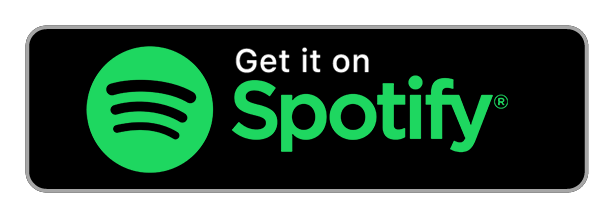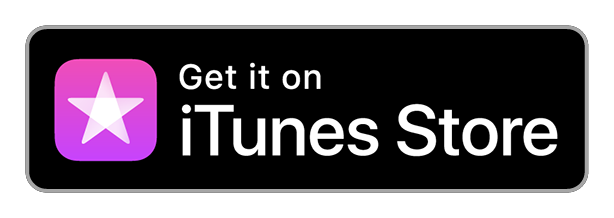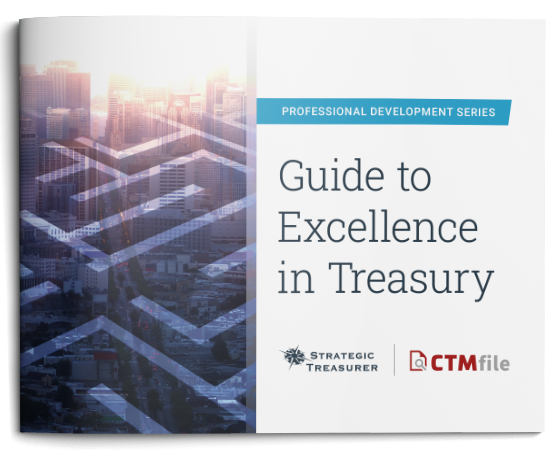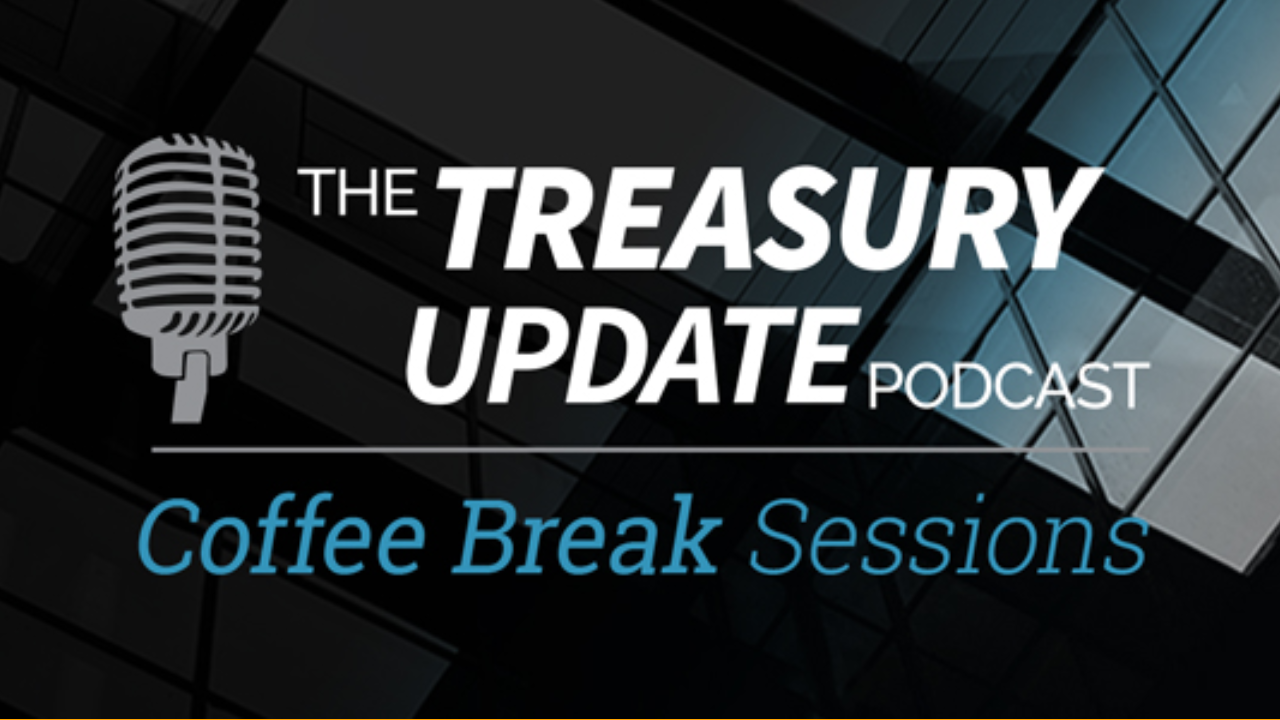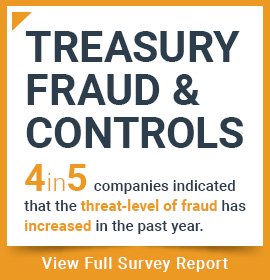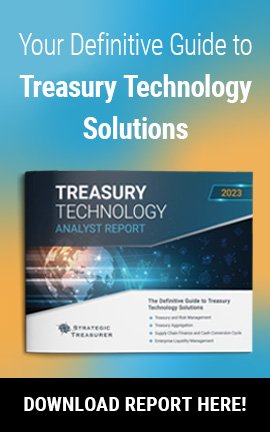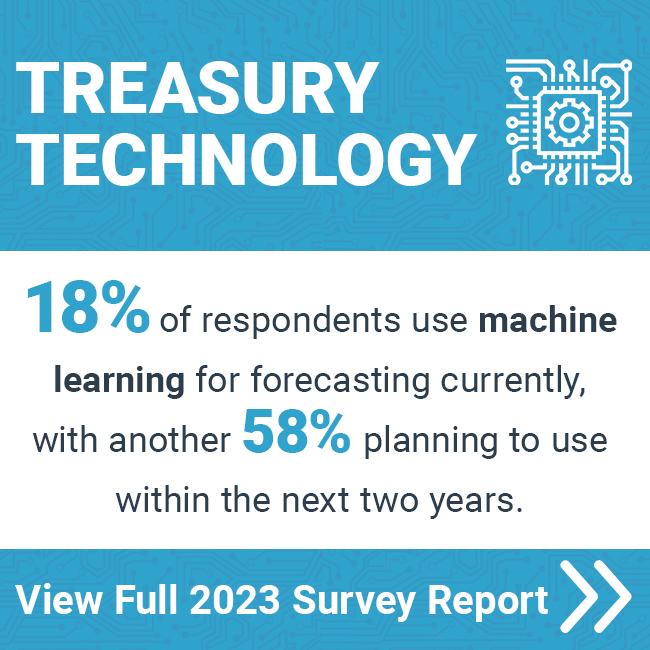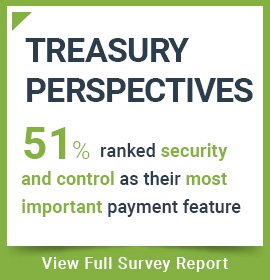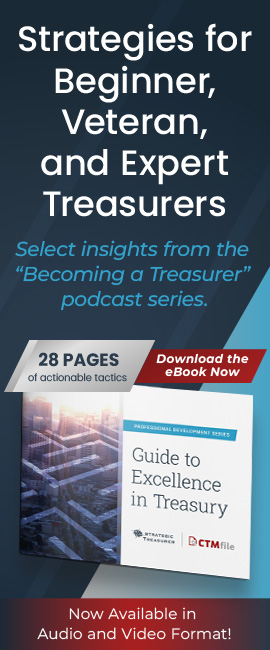
Episode 257
Navigating Treasury’s Evolution: From Visibility to Leverage
In this podcast, Craig Jeffery and Jason Campbell from Strategic Treasurer discuss key elements, the right mindset, and a roadmap for help your treasury team excel. They discuss building the right team, leveraging technology, and establishing effective structures. Equipping your team with the right warning signs and signals is vital, but developing the ability to read and react to these indicators is equally important. Listen in as Craig and Jason unpack this!
Host:
Jason Campbell, Strategic Treasurer


Speaker:
Craig Jeffery, Strategic Treasurer


Episode Transcription - Episode #257 - Navigating Treasury’s Evolution: From Visibility to Leverage transcript
Announcer 00:04
Welcome to the Treasury Update Podcast presented by Strategic Treasurer, your source for interesting treasury news, analysis, and insights in your car, at the gym, or wherever you decide to tune in.
Jason Campbell 00:18
Welcome to another episode of the Treasury Update Podcast. I’ll be your host Jason Campbell, business development leader here at Strategic Treasurer. And joining me today for another great conversation is the man the myth, the legend, our managing partner, Craig Jeffery. Craig, welcome to the show.
Craig Jeffery 00:35
It’s good to talk about these different topics in our comfortable studio here. We love our new studio, which makes recording so easy.
Jason Campbell 00:56
All right, well, Craig, well, listen, I’m so excited to have the opportunity to speak with you, as always, and hopefully our listeners the same way as we learn, you know, again, some more interesting topics and related to the world of treasury. In this episode, we’re going to talk a little bit about visibility to leverage and, you know, really kind of go into talking about the progression of capabilities for treasury moves from visibility, to insight to leverage or the ability to act. So let’s kind of kick this off with this one wonderful question. And what ways is this a mindset? And in what way? Is this a roadmap for organizations?
Craig Jeffery 01:38
Yeah, so you know, when we, when we talk about things like visibility, or insight, or leverage, this is this is the, these are some of the differences. I mean, I’ll give you a few examples. In a from our day to day life, you know, on the wall, you have a thermostat, a thermometer, a thermometer tells you what the temperature is, the thermostat allows you to, you know, adjust it up or down to make it cooler to make it warmer. And so you’re controlling the environment. And so to what extent, the thermostat allows you the leverage, you’re you’re changing the environment, based on the action you do, whereas thermometers, like it’s giving you feedback, here’s what’s going on, it’s like, oh, that’s why I feel so hot, or that’s why it’s colder, or now I need to do something, usually the the information or the visibility, tells you, you know, things are fine. It gives you feedback. So you know, things are fine, things need to be adjusted, and you can take whatever remediation effort that you want to do. And so that’s a difference. When we think about visibility, I can see insight is what does this mean? And then leverage, or the ability to act is how, how can I make changes to what goes on. So that’s an example you know, the thermostat thermometers visibility and leverage, when we look at, you know, an example about insight is, you know, on your car, you have a tack ometer. I guess if you don’t have electric car, I don’t know, I don’t have an electric car. So I don’t know. But you have attack ometer that shows how many RPMs the engine is running. And so there’s, you’re gonna have visibility to that. But there’s also information in scale, like, it will give you warnings, if you’re redlining they there’s a section there’s that it’s red, it may even a light may flash on, that tells you you’re you’re going to high shift to another gear, don’t burn out your engine, there’s insight as to what that means with a tack ometer they get you same thing with like a gas gauge. It’s like, okay, I can see that I’m, I’m almost on empty. And what does that mean? It’s like, and then a light goes on it says get fuel. Those are some areas that give you insight, of course you soft to pull over and put fuel in or charge or whatever you’re doing. So those are the those are the three terms visibility is what can I see at a granular level or with stratification? And so in Treasury, we think about that, where’s my money? What currency? What bank accounts, what banks? What countries? So all these different ways of cutting the information in different dimensions, allows me to see that. But you can also see that in the cash conversion cycle for receivables, payables age has a factor on what jurisdiction are the end, what are the typical collection terms as examples of now I have more insight, and then perhaps I can make a forecast. And then we think about leverages, what can I do to change? what the outcome is like, Oh, it’s great. We’re going to run out of money in 42 days if we don’t do something different. And then what’s the leverage, oh, I can tap a line I can slow down my payables. I can increase sales I can sell something you know have a bit you know, I can again, import a program for Supply Chain Finance, which gives me the ability to stretch out my terms more yet let people collect for And sooner, and now that bought me 50 more days of liquidity. So like, okay, that’s well, within the comfort zone, I’m looking at a new credit facility or issuing some some bonds or notes for that. So it’s a visibility insight, leverage different terms, that means something that means something different.
Jason Campbell 05:18
Yeah, you know, it’s an all great analogies to put them in perspective. And the thing I was thinking notice is like, you know, these are all, you know, you look for indicators, right? And just anything, you know, and your job function itself, looking for those indications that say, Where’s your direction that you’re heading? Appropriate? What action? Should you take, you know, in your fourth year, foreseeing what’s going to happen? Right. So and that’s where it comes into that visibility. We’re talking about the thermometer, which absolutely, you know, the mercury rises but the temperature for a reason. But it’s also to that gives you the the indicator of what how do you need to dress for that day or be prepared for for that day? Do you need to prepare for, you know, long sleeve shirts, you need to pay for shorts, you know, they you know, and also to as you your visibility is looking outside? It’s like, is there clouds in the sky? Well, no, they Gray, then there’s gives her a chance of rain that you need to take and be prepared and what you know, and if anything, if you don’t know, right, because it’s like being a meteorologist, I think meteorologist one of those jobs where as long as you’re 50%, right, you get to keep it, right. And it’s like you know it, but if they say, hey, it’s a 50% chance of rain, probably good chance I need an umbrella I may need it may not need it. But I have it there just in case as a secure safety factor as a precaution, may the same thing, we think about visibility, insight and leverage, right, you’re already having that plan played out in place. And we’ll get into a little bit more here in a second. But you’re already starting to see what that steps are going to look like and how to be prepared and how to ensure that you’re maximizing those opportunities that apparently could be out in front of you. Or if there’s disaster ahead, you’re already making the proper plans and putting them in place to make sure that you can make it through and going into talking about that mindset, because that’s really what it is. Right? Is that mindset and that roadmap and those two pieces? So let’s talk about those, you know, explain the difference besides specificity.
Craig Jeffery 07:17
So the mindset and a roadmap, the mindset is, what’s the concept here? I realized that there’s three different three different aspects to what, what I need to do what I need to know what goes on? And what’s happening. So that’s visibility. The second is, what does that mean? How does that how does that alter what I should do? Or does that give me confidence in what I’m doing is right. And so that’s the Insight element. And then leverage is like, how do I? How do I influence what’s going on? Whether it’s your foot on the pedal, or it’s your finger on the thermostat? Or your, your mouse? On the terms in your supply chain? Financing Program? Those are those are, that’s how I can leverage things. So I think the mindset is, I need all three of these. There’s purposes for each of these, and there’s value in each of these. And each one becomes more important. I can’t, you know, leverage is harder to use, if I don’t have good visibility, if I don’t know what to do, how do I act properly? So I so I need all three, but it’s like, it’s this progression up from visibility, to insight, to pulling on the levers that I have? And how long are those levers right? The longer the lever, the more powerful it is for my organization, because it has a bigger impact. And I won’t, I won’t give the quote about if I had the longest lever, you know, with a long enough lever, you can move the earth. But the idea that how much you can move things, how many days how much capital, how many, how you can capture your your risk management exposures and alter those is very, very efficient. So that’s the that’s the, the overall mindset is, I need these three, to accomplish it. The roadmap is, where am I now? And what do I need to do to have all three in place and have the right things in place with leverage? So you know, oh, can I see all my accounts? All my balances all my transactions every day globally? And do I have the ability to see this and in different dimensions, different views? You know, the example again, is by country, by bank, by currency, by pool by entity, whatever those views are, I need to see that and that’s just talking about currency. But I may need much more visibility. And so roadmap is standard is I need to see all my my balances prior day balances and detailed transactions across the globe. That’s the minimum standard. So roadmap is put that in place. The second part of the roadmap is how do I achieve insight like what are my decision points, like what risk is what exposure level is too much for interest rate risk, or foreign currency volatility. It’s like all these currency pairs if it’s the potential swing from the past As five months of highest peak volatility, if that’s over 5 million, I need to bring it down under 5 million. And so there’s there’s an insight into what matters to us, and what the size is the volatility in this case. So the ability to see just like in the room, it’s like, if it’s under 32 degrees Fahrenheit, or if it’s below zero degrees Celsius, my pipes might freeze, so I can’t turn the thermostat off in the winter, I need to have it on because there’s a freezing element if I leave it too high, and I live in a humid climate that the air system won’t won’t filter out the moisture, and I’ll get mold. And so there’s, there’s what are the insights, you know, in the house in that case, but what level liquidity becomes too tight? What are my minimum standards there so that I know to look at what happens when I come? If I’m going to be within 5% of breaking a covenant on my credit facility, what’s the negative implications of break the covenant facility, lack lack of trust, possible, calling of the note, or most likely, substantial penalties for doing that, or higher rates kicking in and maybe not able to do an acquisition that you’re planning? So knowing what those the Insight is, you know, where are we redlining? What’s the point before redlining, where are we redlining? And where do things break? And so that idea of knowing those levels of insight, and that’s the, that’s a crucial part of that same thing on leverage, how do I how do I make my lever longer? The example might be, oh, we have a sub we put a supply chain finance program in place we do. You know, we do a dynamic discounting type program. Those work better when there’s a longer period of time, let’s say you extended everything out to 60 days, you know, for for pain, but it takes you 30 days to get approval, now your lever can work in that 30 day period, like instead of pain, and they 60 they can collect it on day 30. Well, that’s a certain value. What if you get all of the approvals done in 10 days, and then you can offer it maybe using other people’s money you can offer your recipients your your vendors, the ability to take money 10 days after they’ve shipped and invoiced. And so they’ve got a 50 day lever that they can pull now that’s more valuable to them. And it can be more valuable to you from the the value of the program. And so that’s a that’s a key part and understanding those differences. How do I how do I know what’s going on? What are the key measurements, warning tracks, red lines, margins that I have to be careful with? You know, as an alert, as a serious warning, as a this, we’re not to exceed such and such a number, whether it’s risk, that liquidity exposures, and so on. So those are the those are some of the things that I would say you need to think about.
Jason Campbell 12:56
You know, it’s funny you were talking about you brought up analogy earlier about, you know, the electric car, right that you’re like, I don’t have electric car, you your car itself, and you think about as technology has changed, right? It’s kind of goes back to the same snatcher. It’s not your grandfather’s Treasury world anymore, right? Because there’s so many different things that come into play. And you know, it’s funny when I get my my vehicle to Mike, my wife’s vehicle, she has all the bells and whistles, the sensors, and then the bird’s eye views and all these cameras and everything that it does the sensor, my vehicle, nothing I know, when I hit something, that’s it, okay? No, it was too close. Because I put dead my car or I did something else, because it’s technology has changed so much. And it’s like the computers inside these vehicles are telling you exactly what’s going on in what’s going on within your vehicle itself. And when things need be serviced, things are not right or off or, versus, you know, like, they set their wake up and go look at my tire and you know, put my foot on it to see if I had you know how much resistance I had to know if I need to put air in it or not where now I can just get in, and it tells you the tire pressure, right. And so when I was thinking about when you’re talking about roadmapping itself, and has things have changed, and the options that are available for folks to increase visibility, insight, and leverage, the tools, the resources, the things that are out there, support wise organizations like strategic treasure and other organizations are out there who can help firms also to help with their roadmapping. You know, I was thinking like, how does one start off like building a roadmap that with so many viable options, and things that are out there for an organization says, you know, what, it’s probably time for us to check ourselves and are we putting ourselves in the best position to know exactly what’s going on? Because it is about speed. You know, we can see as you were talking about market volatility, and you know, as things happen overnight, and there’s things with warning, and there’s things without warning, and what’s our our readiness level for, you know, something to make good moves or things that are going to potentially potentially be some bad, it’s bad things going down the way. And I was just thinking myself with all these things were going on. How does one build that roadmap?
Craig Jeffery 14:58
Yeah, so there’s a A number of components to to a roadmap, you know, besides saying what level do I achieve the visibility I need? What areas? Do I need visibility to? What are the dimensions, I need to be able to see it? What’s the timeframe for that? And you know, the frequency that that can be updated? What What insight do I have? What insight do I need to have captured? And then how do I how do I lever that? You know, when I think about the feedback, you talked about the car, and you can tell when you’re close to someone, you know, whenever I travel, and if I’m using a rental car, sometimes I have this, these helpful aids, right? You know, the that sense? Oh, you’re close to the line. And I’ve gotten a car sometimes where it’s, it must have like, you know, it’s so it gives you so much room before the line that this channel is buzzing constantly left or right, you moved one inch over. And it’s buzzing. It’s like, okay, that’s useless. I’m getting warnings for everything. Which means I’m going to ignore it just like you have a faulty smoke alarm. And it just keeps going off. What do people do they pull out the batteries, right? That’s not the right answer. But too many false negatives means that nothing matters, right? You’re like, This can’t be real, you know? Okay, that’s the 15th time that alarms gone off this past week, I’m going to sleep through it to our detriment. So we want to make sure that the insight we have that the, you know, the warnings, the the red lines, they’ll the alerts, etc, are sounding the right, the right scale of alarm, but we think about the roadmap. You know, think about the team, what does the team do? What mindset does the team have? So think about technology, what technology is in place to capture the information to systematize the insight we need to have like, what’s an alert? What’s a warning? What’s the what’s the endpoint so that we were not just like reacting to, you know, overlimit over exposed and then it’s like, okay, how do we, how do we fix a problem? Like, I’d like to know a little bit more when I’m close to the margin what’s occurring? And then not finally, but the other the other piece? Besides technologies is structures. What are the cash management structures that we have in place, the financial structure we have in place to help us solve our challenges with visibility, achieving accurate insight, and then Lovering things. So with that, you know, the team is different people in your organization probably have different strengths according to these categories of visibility, insight, and knowing how to leverage what we can leverage. But making sure the team has the right mindset of knowing that there’s this progression. And that the team has the ability to use the technology to have proper information, good information, accurate information, and then set it up so that on a more automated basis, we’re getting the alerts, the heads up display the the warning light on our dashboard, when those things matter if all of them pop on all the time, you ignore them, right? It’s like, okay, your tires flat, your tires flat, well, the sensors bad. Like, you know, the tire is not flat after 50 times, you know, it’s like, I’m gonna ignore the red lights. Because they’re not going to make sense. So this idea of how do I put in technology place that gives me the right type of alerts, or the right types of warnings and information that can act on on the structure standpoint, is designing your banking structure, so that it’s a modern cash management structure, use a header account or cash concentration structure for commercial size entities and larger, very small companies may have to look at different things, they may not be able to use structures, maybe they have a single operating account per country, everything goes in and out of account. Well, that works fine, it doesn’t make sense to have, you know, three, four or 510 accounts, when you have very, very limited activity. But as you grow, then you isolate those. And that provides some additional guidance and insight. You can see all of your inbound flows, your outbound flows, track and capture potential fraud or errors more readily, you know, across the board from a macro love, not just from a detail reconciliation look. So how do you build the roadmap, you look at the where do we want to be from a visibility, perspective, insight and leverage if those are three way points? And then what does that look like? And what do we need to get there? And so there’s a flow for, you know, team development and responsibility, but what tech do I need to see my exposures to see my you know, see my assets, my balances, my transactions and and then what do I need to do longer term from a structural standpoint, from a bank relationship and account side?
Jason Campbell 19:44
Oh, once you get that roadmap built, get in the car and drive. That’s what I’m talking about. Well, great. Thank you so much for for joining us today. And thank you to the listeners for tuning in to another great episode. And really this one learning about visibility, insight and leverage within your treasury functions and And Greg, thank you so much for joining us. We really do appreciate it. And to our listeners if you got any comments or questions or anything else you’d like to hear from us, please feel free to drop us a note at podcast@StrategicTreasurer.com. And until next time, take care.
Announcer 20:18
You’ve reached the end of another episode of the Treasury Update Podcast. Be sure to follow Strategic Treasurer on LinkedIn. Just search for Strategic Treasurer. This podcast is provided for informational purposes only and statements made by Strategic Treasurer LLC on this podcast are not intended as legal, business, consulting, or tax advice. For more information, visit and bookmark StrategicTreasurer.com.
Subscribe to the Treasury Update Podcast on your favorite app!
Related Resources
Guide to Excellence in Treasury eBook
Whether you’re aiming to become a treasurer, have just landed the job, or have held the position for years but are still seeking ways to improve and grow, this guidebook should have some ideas that will help you and your organization thrive.
Read the eBook today with the button below!

